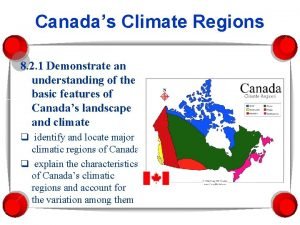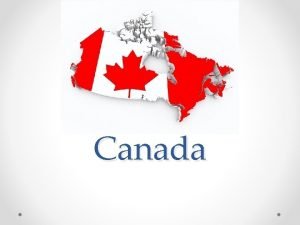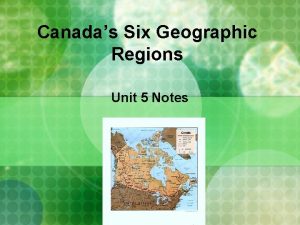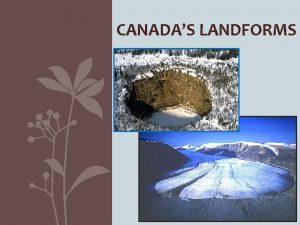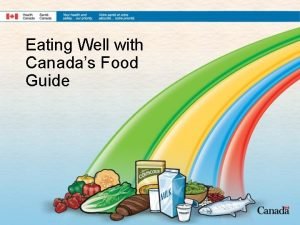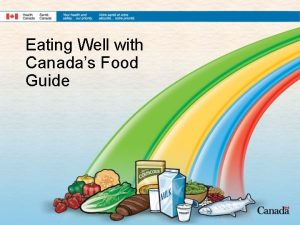Canadas Pandemic Post Pandemic Challenges Opportunities Craig Alexander














- Slides: 14

Canada’s Pandemic & Post Pandemic Challenges & Opportunities Craig Alexander Chief Economist and Executive Advisor March 2021

Canada’s Economic Recovery set to Slow in the Near Term Real GDP, quarter-over-quarter annualized growth 40, 5% 50% 10% 0, 4% 4, 3% 1, 8% 9, 2% 0, 4% 2, 5% 7, 9% 12, 4% 21 Q 1 f 21 Q 2 f 21 Q 3 f 5, 8% -7, 3% -30% -38, 1% -70% 2019 Q 1 19 Q 2 19 Q 3 19 Q 4 20 Q 1 20 Q 2 20 Q 3 20 Q 4 f 21 Q 4 f Real GDP, annual growth 6% 4, 5% 3, 0% 4% 2% 2, 4% 1, 0% 4, 9% 1, 9% 2, 3% 1, 9% 1, 8% 2023 f 2024 f 2025 f 0% -2% -4% -6% 2016 2017 2018 2019 -5, 4% 2020 f 2021 f 2022 f Sources: Deloitte, Statistics Canada © 2021 Deloitte LLP and affiliated entities Economic Overview 2

Provincial Performance varied, but all to Return to Growth in 2021 Decline in real GDP in 2020 GDP growth in 2021 AB PE ON NS BC NB NL PE QC MB ON CAD MB NS CAD QC SK NB BC SK AB NL -10, 0% -8, 0% -6, 0% -4, 0% -2, 0% 0, 0% 1, 0% 2, 0% 3, 0% 4, 0% 5, 0% 6, 0% Sources: Statistics Canada, forecasts by Deloitte © 2021 Deloitte LLP and affiliated entities Economic Overview 3

© 2021 Deloitte LLP and affiliated entities February to peak decline, percent Agriculture, forestry, fishing, and hunting Finance and insurance Utilities Real estate and rental and leasing Public administration Information and cultural industries Management of companies and enterprises Professional, scientific, and technical services Mining, quarrying, and oil and gas extraction Educational services All industries Health care and social assistance Wholesale trade Construction Transportation and warehousing excluding air Manufacturing Administrative and waste management Retail trade Other services Arts, entertainment, and recreation Accommodation and food services Air transportation Varied Industry Performance leads to talk of a ‘K’ Shaped Recovery with Implications for Cities Real GDP: peak decline in output (bottom point) and change from February to November 2020 (top point) Percent Change 0% -20% -40% -60% -80% -100% February to November, percent Sources: Deloitte, Statistics Canada Economic Overview 4

Small Businesses most Impacted Employment decline in April compared to February and October Compared to February by establishment size Index 500 0 -500 -1 000 -1 500 -2 000 -2 500 -3 000 -3 500 Total employees, all establishment sizes Less than 20 employees 20 to 99 employees Employment Decline by April 100 to 500 employees More than 500 employees Employment Decline by October Sources: Deloitte, Statistics Canada © 2021 Deloitte LLP and affiliated entities Economic Overview 5

2010 Q 1 10 Q 2 10 Q 3 10 Q 4 11 Q 1 11 Q 2 11 Q 3 12 Q 4 12 Q 1 12 Q 2 12 Q 3 12 Q 4 13 Q 1 13 Q 2 13 Q 3 13 Q 4 14 Q 1 14 Q 2 14 Q 3 14 Q 4 15 Q 1 15 Q 2 15 Q 3 15 Q 4 16 Q 1 16 Q 2 16 Q 3 16 Q 4 17 Q 1 17 Q 2 17 Q 3 17 Q 4 18 Q 1 18 Q 2 18 Q 3 18 Q 4 19 Q 1 19 Q 2 19 Q 3 19 Q 4 20 Q 1 20 Q 2 20 Q 3 20 Q 4 f 21 Q 1 f 21 Q 2 f 21 Q 3 f 21 Q 4 f 22 Q 1 f 22 Q 2 f 22 Q 3 f 22 Q 4 f 23 Q 1 F 23 Q 2 F 23 Q 3 F 23 Q 4 F Large increase in Savings sets stage for Strong Rebound Household savings $C billions at quarterly rates 120 100 80 60 40 20 0 Sources: Statistics Canada, forecasts by Deloitte. © 2021 Deloitte LLP and affiliated entities Economic Overview 6

Government support has come with a Massive Price Tag Net Debt (% of GDP) in 20201 180% 168, 9% 160% 142, 7% 140% 120% 107, 0% 106, 7% 100% 85, 9% 85, 0% 80% 60% 50, 8% 49, 2% 40% 20% 0% Canada Fed + Prov France Germany Italy Japan United Kingdom United States Sources: Haver Analytics; Statistics Canada; Department of Finance © 2021 Deloitte LLP and affiliated entities Economic Overview 7

COVID-19 has created massive disruption, while structural forces are still in play STRUCTURAL TRENDS ACCELERATING TRENDS EMERGING TRENDS Addressing climate change Increased debt for households, businesses and government Disrupted or changing supply chains Demographic change Shift to digital Industrial sovereignty/protectionism Weak investment and poor productivity Changing nature of work Increased role of government Low interest rates Increase in automation and AI Change in consumer behaviour © 2021 Deloitte LLP and affiliated entities Economic Overview 8

The pandemic has varying impacts on industries’ recovery depending on the degree of exposure to economic closures, and the ability and speed of adaptation Very Resilient Government and Public admin Professional Scientific and Technical Services Resilience to COVID Utilities Financial services Education Health Culture and Publishing Broadcasting Wholesale Extractive Manufacturing Severely impacted Low potential © 2021 Deloitte LLP and affiliated entities Telecom and Data Transportation and warehousing Agriculture and Forestry Retail Arts, Entertainment, and Recreation Construction Acc. and food svcs. Post-COVID growth potential Motion pictures and sound recording High potential Economic Overview 9

Weaker labour force growth, abysmal investment and subdued productivity gains mean Canada’s baseline trajectory is one of soft economic growth • Given slowing labour force growth, weak business investment, and slow productivity growth, gains in potential output will remain well below 2 per cent. • Weak potential growth means slower growth in living standards as income per capita increases at a slower pace. • This can lead to broader, societal risks including rising populism, nationalism and protectionism which goes against the diversity that Canada has fought to build. Potential output growth Deloitte LLP, Percent Change 4, 5 4 3, 5 3 2, 5 2 1, 5 1 © 2021 Deloitte LLP and affiliated entities Economic Overview 30 f 29 f 27 f 28 f 26 f 24 f 25 f 23 f 22 f 21 f 19 20 f 17 18 16 15 14 13 11 12 10 08 09 07 06 04 05 03 01 02 99 2000 98 97 5 96 94 92 93 91 0 1990 0, 5 10

While GDP growth slows, aging demographics and rising health care costs will add fiscal strain Average health care costs per age cohort and growth in population CIHI and Deloitte LLP $C Percent 35 000 6, 00% 5, 00% 30 000 4, 00% 25 000 3, 00% 20 000 2, 00% 15 000 1, 00% 10 000 0, 00% 5 000 -1, 00% 0 -2, 00% Age 0 -1 Age 1 -4 Age 5 -9 Age 10 -14 Age 15 -19 Age 20 -24 Age 25 -29 Age 30 -34 Age 35 -39 Males © 2021 Deloitte LLP and affiliated entities Age 40 -44 Females Age 45 -49 Age 50 -54 Age 55 -59 Age 60 -64 Age 65 -69 Age 70 -74 Age 75 -79 Age 80 -84 Age 85 -89 Age 90+ growth in population Economic Overview 11

Pandemic is a Perfect Storm for Municipalities Greatest health crisis and deepest recession in modern history Inequitable industry impact, hardest hit were services - more exposure in large cities Job losses concentrated in the most vulnerable Dramatic shift to digital and move to remote work, come shift out of urban centres – impact housing and transit Weakness in commercial real estate Loss of revenues Increase in demand for public services Perfect storm for cities Pandemic and recession revealed inadequacies pre-COVID: inequality. income security, childcare, seniors, affordable housing challenge, infrastructure gap © 2021 Deloitte LLP and affiliated entities Economic Overview 12

Need to Recover but also put Canadian Cities and People on a More Prosperous Path Create inclusive, sustainable growth • Regional economic strategy for recovery and development • Skills agenda • Affordable housing • Invest in social determinants of health Infrastructure as a Regional Catalyst (shift to regional coordinated funding that is future oriented) • More digital, more green • Expedite high-capacity broadband • Make transportation seamless and attractive • Target GHG reduction in largest sectors Coordinated and Responsive Government • Automation, e-commerce, remote work could add to financial strains • Regional procurement models • Encouraging local innovators to find digital solutions • Improve serve delivery • Regulatory reform and realignment • Support a new deal for cities • Digitize, open and innovate government • Harmonize and simply municipal procurement processes and procedures © 2021 Deloitte LLP and affiliated entities Economic Overview 13

Deloitte, one of Canada's leading professional services firms, provides audit, tax, consulting, and financial advisory services. Deloitte LLP, an Ontario limited liability partnership, is the Canadian member firm of Deloitte Touche Tohmatsu Limited. Deloitte refers to one or more of Deloitte Touche Tohmatsu Limited, a UK private company limited by guarantee, and its network of member firms, each of which is a legally separate and independent entity. Please see www. deloitte. com/about for a detailed description of the legal structure of Deloitte Touche Tohmatsu Limited and its member firms. The information contained herein is not intended to substitute for competent professional advice. © 2021 Deloitte LLP and affiliated entities.
 Canadas climate
Canadas climate 90 of the canadian population lives within
90 of the canadian population lives within What is canadas economic system
What is canadas economic system Whats canadas longest river
Whats canadas longest river Electromagnetismo
Electromagnetismo Temperatura en las cañadas del teide
Temperatura en las cañadas del teide Canadas 5 regions
Canadas 5 regions Canadas physical regions
Canadas physical regions Canadas landforms
Canadas landforms Who is canadas head of state
Who is canadas head of state Challenges of media information
Challenges of media information Greater bay area opportunities and challenges
Greater bay area opportunities and challenges Interpandemic period
Interpandemic period Mathalicious pandemic answer key
Mathalicious pandemic answer key Pandemic tabletop exercise template
Pandemic tabletop exercise template
